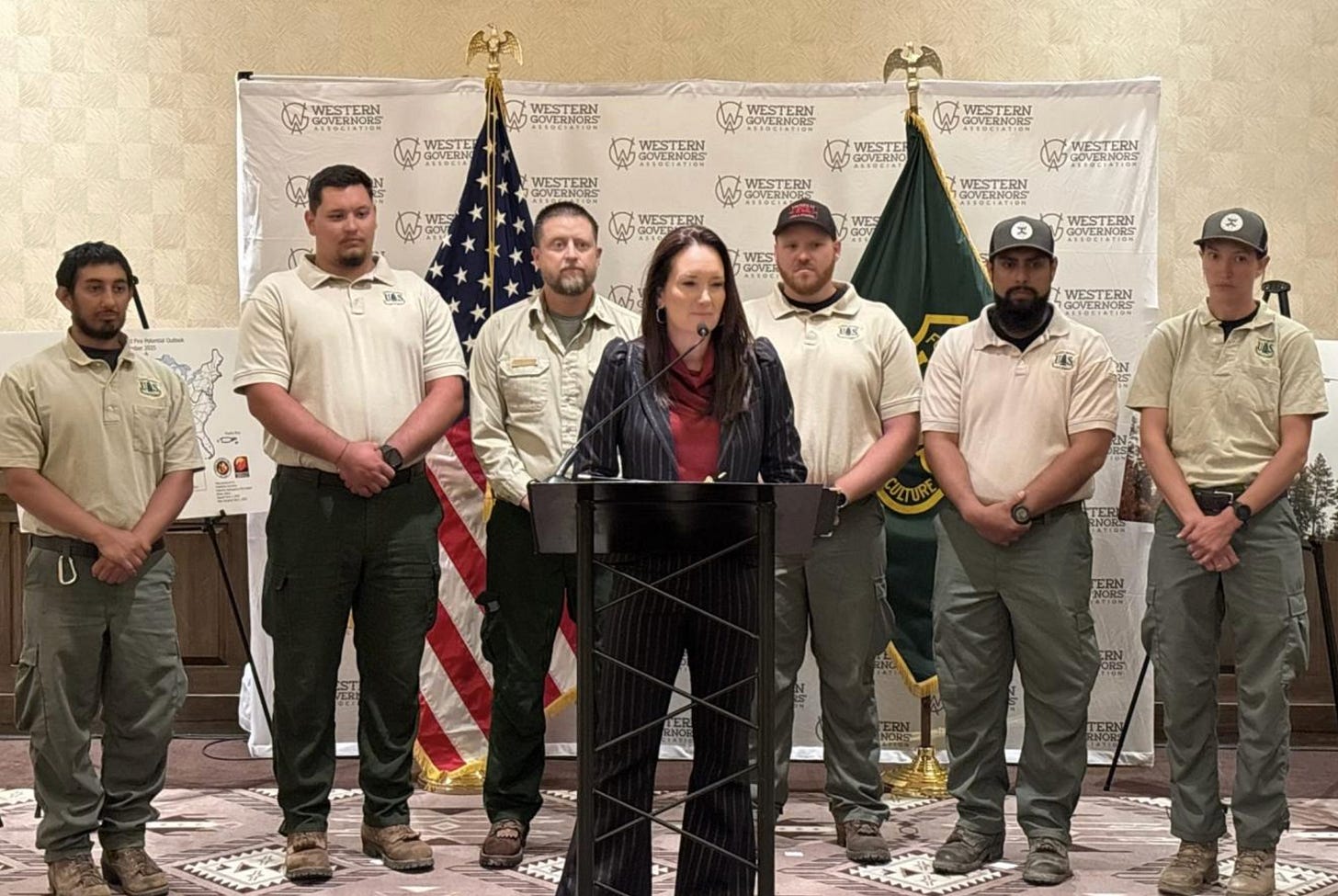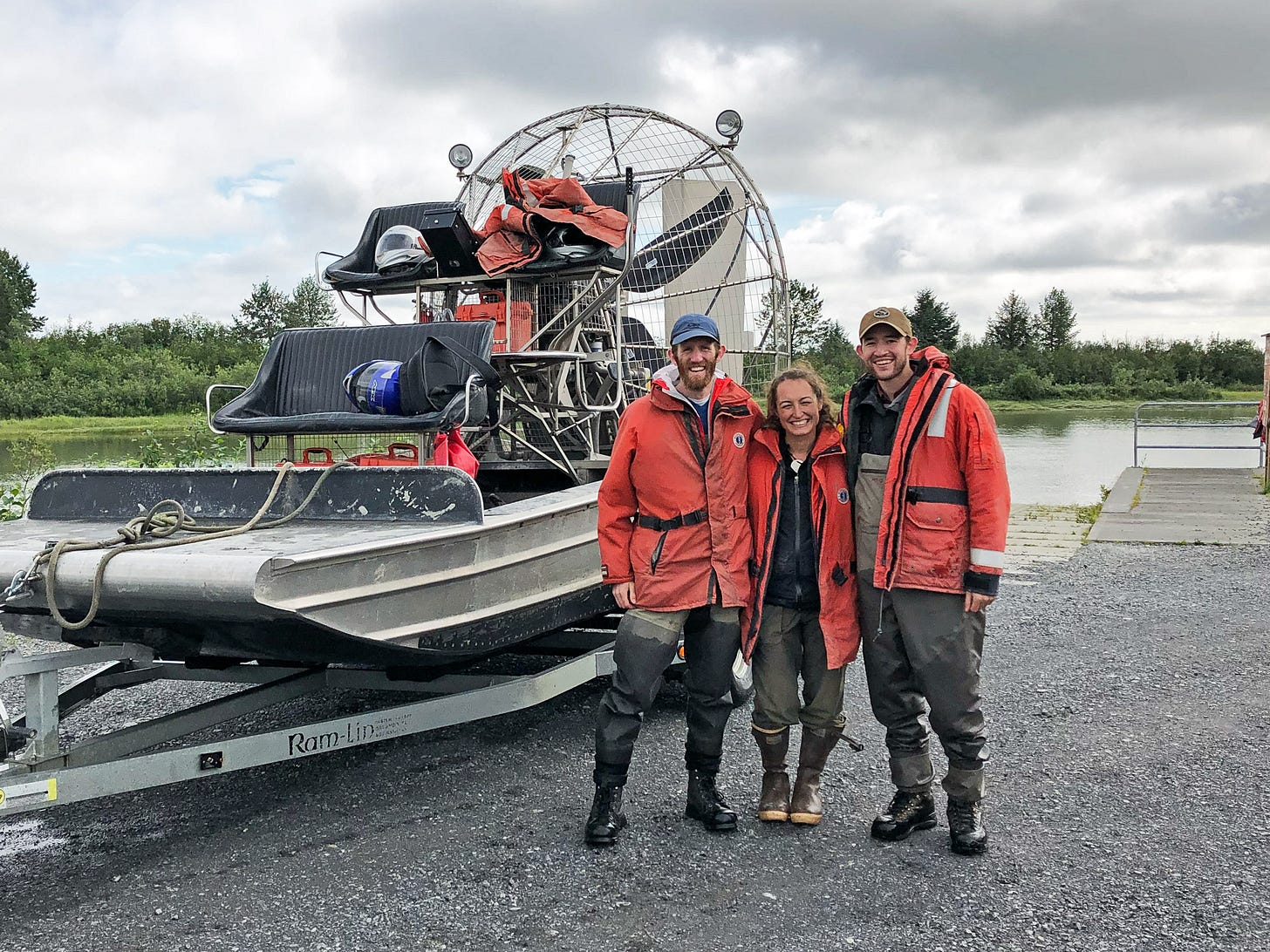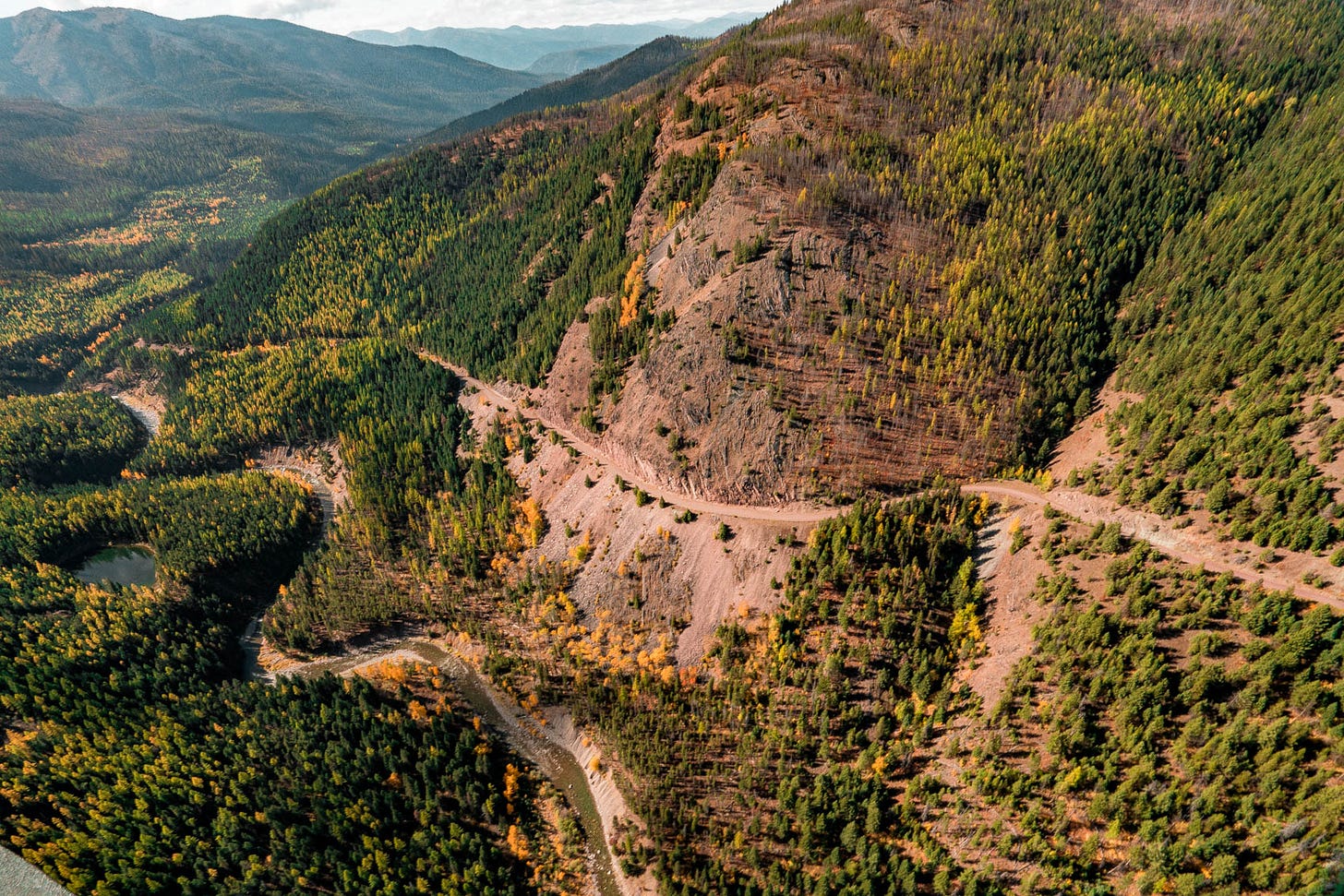The Roadless Rule Explained: How the Last Unbroken Forests Could Be Lost Forever
For 25 years it has protected 59 million acres of wild forest. The latest repeal puts them all at risk.
We’ve received a number of emails lately on this topic lately so I figured we might as well add it to our explainer series!
You can consider the Roadless Rule as a sort of invisible fence around some of America’s last unbroken forests. For nearly twenty-five years, it has kept bulldozers, chainsaws, and asphalt out of places where the only paths are carved by rivers and wildlife. Most people who camp, hunt, fish, or hike in national forests have never heard of it, yet they have almost certainly walked its legacy.
These are landscapes that have remained unmarred by man since the beginning of time. Old growth that has stood for centuries. Primeval forests where the silence is broken only by wind and water. Nature in its purest form. Without the Roadless Rule, many of these places would already bear the scars of logging roads and heavy machinery.
Lately, this rule has been getting more attention as new efforts to dismantle it gather momentum. Industry groups and their political allies are pushing to open up millions of protected acres for logging, mining, and road-building. If they succeed, places that have remained untouched for as long as memory reaches could be changed in a single season.
This is the second piece in our new series on the laws, policies, and overlooked tools that stand guard over wild rivers, ancient trees, and the places industry sees as raw inventory. We began with NEPA, the law that forces agencies to put environmental damage on the record before they act. Now we turn to the Roadless Rule, a policy born at the turn of the millennium that still decides which corners of our national forests stay truly wild
What the Roadless Rule Is
The Roadless Rule was created in 2001 to protect some of the wildest, least disturbed parts of the national forest system. These places are called Inventoried Roadless Areas - a formal designation the U.S. Forest Service uses for large tracts of land, usually 5,000 acres or more, that have no permanent roads and remain largely undeveloped.
The inventory was built over decades of mapping and field surveys. It identified millions of acres where the land still holds its original character – continuous forest, healthy watersheds, and intact wildlife habitat. Once an area is added to this list, the Roadless Rule steps in to limit what can be done there.
The rule does not lock the gate to people. Hunting, fishing, hiking, camping, and other recreation are still allowed. So are activities like habitat restoration, wildfire prevention, or even building small temporary roads for emergencies. What the rule mostly stops is permanent road construction, road reconstruction, and large-scale commercial logging.
This matters because roads are often the first cut into a landscape. Once they are built, they fragment habitat, invite invasive species, and most devastatingly make it possible for industrial activity to move in. By keeping these areas roadless, the policy preserves wildlife corridors, protects drinking water for millions, and keeps some of the nation’s last truly wild forests in the same condition they have been for centuries.
History of the Roadless Rule
The Roadless Rule was born out of a growing realization in the 1990s that America’s national forests were disappearing under a web of logging roads. By then, the Forest Service managed over 380,000 miles of roads, more than eight times the length of the interstate highway system. Many were built for short-term logging contracts but left behind long-term ecological costs.
In 1999, President Clinton ordered the Forest Service to protect the country’s remaining undeveloped forests. After two years of public hearings and a staggering 1.6 million comments, the most ever received on any federal rule at the time, Clinton finalized the Roadless Area Conservation Rule in January 2001. It covered roughly 58.5 million acres and prohibited new permanent road construction, road reconstruction, and large-scale commercial logging, with exceptions only for wildfire control, public safety, or essential habitat restoration.
From the start, the rule was politically charged. Lawsuits flew in both directions. The Bush administration tried to weaken it by creating a process that let states petition for exemptions. It took more than a decade of litigation before the policy was largely restored nationwide. Some states, including Colorado and Idaho, created their own versions of the rule with varying levels of protection.
One of the most contentious battlegrounds was Alaska’s Tongass National Forest. In 2020, the Trump administration removed Roadless Rule protections from more than 9 million acres there, opening the forest to road-building and logging. The Biden administration restored those protections in 2023.
You can probably guess what came next – in June 2025, the Trump administration launched its most sweeping assault on the rule to date. Agriculture Secretary Brooke Rollins announced the repeal of the Roadless Rule nationwide, eliminating protections on nearly 59 million acres. Officials claimed the change would promote “responsible forest management” and economic opportunity, particularly in states such as Utah and Montana where most Forest Service land had been off limits.

Conservation groups warned that the move would fragment pristine forests, threaten drinking water sources, harm wildlife, lead to the destruction of old growth forests, increase wildfire risk, and undermine climate resilience. Legal challenges are already underway (thank you Earthjustice!), but for now, landscapes that have remained untouched for centuries face their most serious threat since the rule was created.
Roadless Rule in Action
Below are some of the great examples of the roadless rule in action doing exactly what it was designed to do – preserve our pristine landscapes and protect them from greedy, grubbing industry wolves.
Tongass National Forest, Alaska
The largest national forest in the United States, the Tongass is a 16.7-million-acre temperate rainforest that stores more carbon than any other national forest. Many of its stands are true old growth, with trees more than 800 years old that have never been logged. The Roadless Rule kept more than half of the Tongass off-limits to new roads and large-scale logging for nearly two decades. When protections were lifted in 2020, timber sales began moving forward in these ancient stands. The Biden administration restored the rule in 2023, but the 2025 repeal threatens to reopen the forest to industrial logging.
Chugach National Forest, Alaska
The Chugach is the second-largest national forest in the country, stretching from Prince William Sound to the Copper River Delta. Its roadless areas protect vital salmon habitat, some of the most productive bear country in the world, and glacier-carved fjords that draw visitors from around the globe. Without the Roadless Rule, new roads could carve into intact watersheds and open the door to mining and logging that would alter the region forever.
Greater Yellowstone Ecosystem, Wyoming and Montana
Roadless areas in the national forests surrounding Yellowstone National Park form critical wildlife corridors for grizzlies, wolves, elk, and other species. They connect the park to other protected lands across the Northern Rockies. Without these protections, new roads and logging could fracture these corridors, reducing the resilience of one of the most intact temperate ecosystems left on the planet.
Southern Appalachians, North Carolina
In the Nantahala and Pisgah National Forests, roadless protections safeguard old-growth remnants and the headwaters of major river systems. These areas provide clean drinking water to communities across the Southeast and form the backbone of a thriving outdoor recreation economy. New road construction here would damage fragile slopes, degrade streams, and threaten rare plant and animal species that survive in isolated mountain habitats.
Colorado’s High Country
Colorado’s 2012 state-specific version of the Roadless Rule adds extra protection to high-value backcountry while allowing for some local needs. These areas include alpine headwaters that supply drinking water to millions along the Front Range. Without roadless protections, road construction could cut into fragile ecosystems that recover slowly from disturbance.
Idaho’s Backcountry
Idaho’s state-specific rule, finalized in 2008, covers about 9.3 million acres. While it allows more logging and road construction than the national standard, it still preserves vast stretches of habitat for species like wolverine, lynx, and bull trout. Losing the national rule could pressure Idaho to further weaken its protections, leaving much of this backcountry open to industrial use.
These examples show what is at stake. The repeal of the Roadless Rule does not just erase a policy. It erases a physical barrier that has kept wild forests and watersheds intact for decades and, in some cases, for centuries.
What You Can Do Now
The fight over the Roadless Rule will decide the fate of nearly 59 million acres of the wildest public land left in the United States. These are forests that have remained unmarred for centuries, home to old growth that will never return once cut. They are the headwaters of major rivers, the migration corridors of threatened wildlife, and some of the last places where you can still walk for days without crossing a road.
If this matters to you, speak up.
Share this post with folks who may not know what it is or why it’s important.
Contact your members of Congress and tell them you oppose the repeal of the Roadless Rule.
Support organizations that are taking this fight to the courts (like Earthjustice & The Wilderness Society) and defending it in the public arena.
The Roadless Rule survived past attempts to dismantle it because the public refused to let it die quietly. That same pressure is needed now. Once these forests are cut, mined, or divided by roads, they are gone for good. The window to act is open, but it will not stay that way for long.

Until next time,
Will





Regrettably, the “Roadless Rule” has come into conflict with the “Lawless Rule.” Unlike the Roadless Rule, the Lawless Rule is the actions of a regime that simply does not believe in the rule of law. Whether it’s trampling the rights of citizens, issuing presidential pardons to domestic terrorists, levying tariffs against countries which act to punish their own lawbreakers, selling off our public lands to the highest bidders or performing countless other acts which violate the Constitution of the United States, not to mention the high ideals which all of our elected leaders ought to aspire to, this regime has committed itself to the destruction of the American democracy. I have labeled their despicable actions the “Lawless Rule.” Agricultural Secretary Brooke Rollins (a.k.a. the “Little Villain”) is among a constellation of larger villains who are acting in concert to transform a once great democracy into a banana republic. As you have pointed out, if this matters to us then it’s time that we speak out and keep speaking out until our elected representatives start listening.
For the very first time I have to partially disagree. In the lower 48 I fully agree. But with climate change and the increasing burning of the boreal forests worldwide, don't we have to make an exception in Alaska's case and put in fire lanes or some such access for fire mitigation purposes? The picture in my mind of such lanes is ugly but the idea of the whole forest being burnt is even uglier.